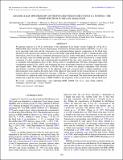CHANDRA X-RAY SPECTROSCOPY OF THE FOCUSED WIND IN THE CYGNUS X-1 SYSTEM. I. THE NONDIP SPECTRUM IN THE LOW/HARD STATE
Author(s)
Hanke, Manfred; Wilms, Jörn; Nowak, Michael A.; Pottschmidt, Katja; Schulz, Norbert S.; Lee, Julia C.; ... Show more Show less
DownloadHanke-2009-CHANDRA X-RAY SPECTR.pdf (1.075Mb)
PUBLISHER_POLICY
Publisher Policy
Article is made available in accordance with the publisher's policy and may be subject to US copyright law. Please refer to the publisher's site for terms of use.
Terms of use
Metadata
Show full item recordAbstract
We present analyses of a 50 ks observation of the supergiant X-ray binary system Cygnus X-1 (Cyg X-1)/HDE226868 taken with the Chandra High Energy Transmission Grating Spectrometer (HETGS). Cyg X-1 was in its spectrally hard state and the observation was performed during superior conjunction of the black hole, allowing for the spectroscopic analysis of the accreted stellar wind along the line of sight. A significant part of the observation covers X-ray dips as commonly observed for Cyg X-1 at this orbital phase, however, here we analyze only the high count rate nondip spectrum. The full 0.5–10 keV continuum can be described by a single model consisting of a disk, a narrow and a relativistically broadened Fe Kα line, and a power-law component, which is consistent with simultaneous Rossi X-Ray Timing Explorer broadband data. We detect absorption edges from overabundant neutral O, Ne, and Fe, and absorption line series from highly ionized ions and infer column densities and Doppler shifts. With emission lines of He-like Mg xi, we detect two plasma components with velocities and densities consistent with the base of the spherical wind and a focused wind. A simple simulation of the photoionization zone suggests that large parts of the spherical wind outside of the focused stream are completely ionized, which is consistent with the low velocities (<200 km s[superscript −1]) observed in the absorption lines, as the position of absorbers in a spherical wind at low projected velocity is well constrained. Our observations provide input for models that couple the wind activity of HDE 226868 to the properties of the accretion flow onto the black hole.
Date issued
2008-12Department
MIT Kavli Institute for Astrophysics and Space ResearchJournal
Astrophysical Journal
Publisher
IOP Publishing
Citation
Hanke, Manfred, Jörn Wilms, Michael A. Nowak, Katja Pottschmidt, Norbert S. Schulz, and Julia C. Lee. “ CHANDRA X-RAY SPECTROSCOPY OF THE FOCUSED WIND IN THE CYGNUS X-1 SYSTEM. I. THE NONDIP SPECTRUM IN THE LOW/HARD STATE .” The Astrophysical Journal 690, no. 1 (December 1, 2008): 330–346. © 2009 The American Astronomical Society
Version: Final published version
ISSN
0004-637X
1538-4357